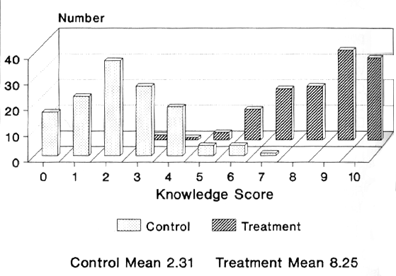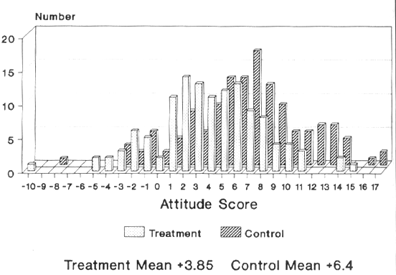Fall 1993 // Volume 31 // Number 3 // Feature Articles // 3FEA7
Contrasting Viewpoints About Controversial Issues
Abstract
Controversial issues are inherently explosive and can be a breeding ground for decision making based on emotional responses. How can education best be provided in these situations without becoming part of the controversy? The contrasting viewpoints method provides an educational tool that offers thorough investigation of value judgments and belief structures while simultaneously presenting the evidence involved in the controversy.
Extension educational efforts to address controversial issues have typically revolved around the notion of Extension educators serving in the role of an objective third party. Popular methods used in public policy or public issues education, such as the "alternatives and consequences" approach, are proven and effective means to deal with controversial issues. These traditional methods may, however, be best suited to addressing specialized issues with precise and distinctive options and effects other than broad, complex social questions steeped in value judgments. A "contrasting viewpoints" method may be more appropriate for preliminary Extension educational efforts about controversial or contentious issues.
"Contrasting Viewpoints" Defined
The contrasting viewpoints method concentrates on the thorough examination of value judgments and belief structures as well as the empirical evidence involved in a particular controversial issue.
Using this approach enables the Extension educator to provide clientele with a broad, general look at different perspectives of a controversial issue. Bender and Leone state the essence of this educational method: "Those who do not know their opponents' arguments do not completely understand their own."1 The explicit objective of contrasting viewpoints isn't to tell the audience what to think about an issue, but to help them think about the issue by the examination of different perspectives.
Examination of different viewpoints promotes an enhanced perspective and comprehension of the subject or issue of concern. Presenting contrasting viewpoints can result in a moderation of attitudes or a depolarization of a very contentious issue.
The purpose of using the contrasting viewpoints method isn't to arrive at a policy decision, but to have participants more informed at the conclusion of the educational activity than they were at the beginning. This is what makes the approach unique and significant.
This method was implemented in a study involving county Extension agricultural agents in an educational program about animal rights/welfare issues.
The Study
The purpose of this study was two-fold: to determine the effectiveness of the "What's the Beef/Here's the Beef" educational program and to demonstrate the contrasting viewpoints method of addressing controversial issues. "What's the Beef/Here's the Beef' is a one-hour program introducing participants to the major concerns of the animal rights/welfare movement related to animal agriculture. The program is centered around two videos that examine this issue from different perspectives. The "What's the Beef" video represents the animal agriculture perspective and the "Here's the Beef" video highlights the animal activist perspective. The program addresses this controversial issue by examining contrasting viewpoints concerning the well-being of farm animals, the wise use of natural resources, and the safety of the nation's food supply. An accompanying lecture draws out major points made by the videos and offers supporting information designed to provoke critical thinking regarding this subject.
Methods
In Fall 1991, 258 county agriculture agents with the Texas Agricultural Extension Service participated in this study. Agents were exposed to the experimental treatment at district training sessions from August through November. A post-test-only control group experimental design with 13 blocks was used in this study.
Participants at each test site were assigned randomly and equally into two groups-a treatment group and a control group. The post-test was first administered to the control group only. The treatment was administered to the treatment group (members of the control group, who had already completed the post-test, simultaneously received the treatment). The post-test was then administered to the treatment group only. The participant evaluation was administered to both groups.
The data collected for the study consisted of: individual demographic information and a knowledge score derived from each participant's responses to 10 multiple choice questions about animal rights/welfare and animal production practice subject matter. An individual attitude score, the sum of 10 attitudinal questions on the subject measured on a five-point Likert scale, was also computed. Individual attitude scores could range from +20 (extreme animal agriculture position) to -20 (extreme animal rights' position). Scores closer to 0 on this scale are assumed to be indicative of a moderate attitude about the issue. Data regarding agent evaluation of the program were also collected.
Operational objectives for the study were to:
- Compare the subject-matter knowledge and attitudes about animal
rights/welfare issues of participants exposed to the "What's the
Beef/Here's the Beef" educational program to those who hadn't been
exposed to the program.
- Have participants evaluate the "What's the Beef/Here's the Beef" educational program.
Results
Demographic characteristics of participants didn't differ whether they were members of the control group or the treatment group. These data were helpful in determining that the treatment and the control groups were homogeneous.
The distribution of knowledge scores is shown on Figure 1. The mean knowledge score of agents in the control group was 2.31, or they answered 2.31 questions correctly out of a possible 10. The treatment group mean was 8.25 questions correct out of a possible 10. Analysis of variance of knowledge scores by treatment, blocked for effect of variation by test site, reveals that the difference in knowledge scores between treatment and control groups was statistically significant (p < .001).

Figure 1. Knowledge score distribution.
Totals of the attitude scores are shown on Figure 2. The mean attitude score of the agents in the control group was +6.40. the treatment group mean attitude score was +3.85. Analysis of variance of attitude scores by treatment, blocked for effect of variation by test site, showed that the difference in attitude scores between treatment and control groups was statistically significant (p < .001).

Figure 2. Attitude score distribution.
Ninety-two percent of the agents rated the "What's the Beef/Here's the Beef" educational program as effective or very effective. Ninety-seven percent of the agents also stated that they'd make use of the "What's the Beef" video and facilitator guide if it were made available to them.
Conclusions and Implications
This study indicated that the "What's the Beef/Here's the Beef" educational program increased the subject-matter knowledge and changed the attitudes of participants who were exposed to the program. The inference can also be made that the experimental treatment was instrumental in bringing about any attitude moderation among those who viewed the program. The moderation of attitudes exhibited in this study reflects the "inoculation theory" proposed in the persuasion literature. "Inoculation theory" suggests that inducing resistance to future persuasion is obtained by giving people inoculatory treatments involving exposure to "small doses" of the opposing view.2 The result is a moderation in attitude that should be more resistant to persuasion from either extreme in the future. From data obtained from the participant evaluation, the assumption can also be made that this example of the contrasting viewpoints method of addressing controversial issues was effective in providing prudent and much-needed education on this issue.
The most powerful conclusion to be drawn from the study was the fact that a group of well-educated subjects who have deeply felt emotional underpinnings on such a controversial issue could have their attitudes moderated by exposure to a one-hour educational program. This suggests that materials of questionable validity disseminated by some extreme animal rights' organizations could be just as effective in altering the general public's attitudes. This would seem to indicate the need for Extension educational efforts concerning this issue.
Summary
Controversial issues are inherently explosive and can be a breeding ground for decision making based on emotional responses. How can education best be provided in these situations without becoming part of the controversy? The contrasting viewpoints method provides an educational tool that offers thorough investigation of value judgments and belief structures while simultaneously presenting the evidence involved in the controversy. Mill offers a persuasive case for the contrasting viewpoints method in this excerpt from On Liberty:
The only way in which a human being can make some approach to knowing the whole of a subject is by hearing what can be said about it by persons of every variety of opinion and studying all modes in which it can be looked at by every character of mind. No wise man ever acquired his wisdom in any other mode but this.3
Mill's quote is used in the concluding segment of the "What's the Beef/Here's the Beef" educational program. Those who view the program have difficulty disagreeing with such logic. The Extension Service may best serve its educational mission by valuing and presenting "every variety of opinion" as it relates to the "whole of a subject." Such an approach promotes a broader perspective, a more comprehensive understanding, and an expanded "wisdom."
Footnotes
1. David L. Bender and Bruno Leone, Animal Rights: Opposing Viewpoints (San Diego: Greenhaven Press, 1989), p. 1.
2. William J. McGuire, "The Effectiveness of Supportive and Refutional Defenses in Immunizing and Restoring Beliefs Against Persuasion," Sociometry, XXIV (June 1961), 184-97.
3. John S. Mill, On Liberty (New York: W. W. Horton and Co., 1975), p. 21.
